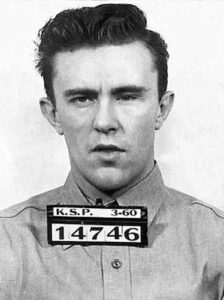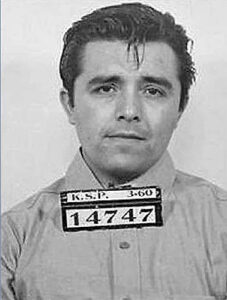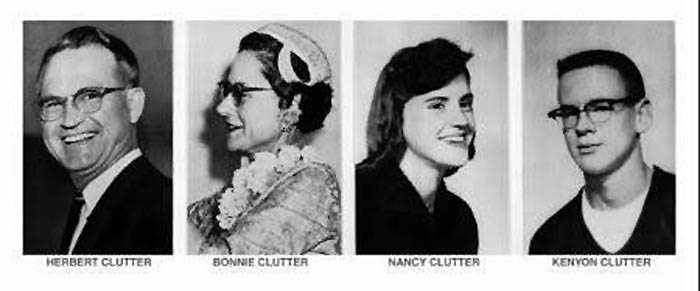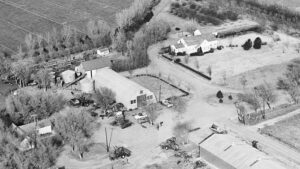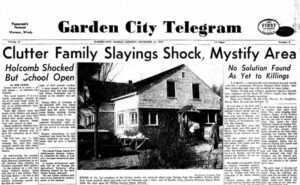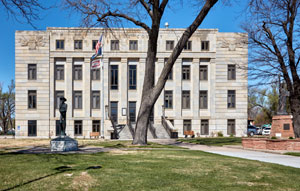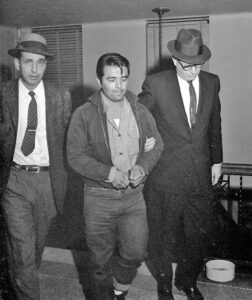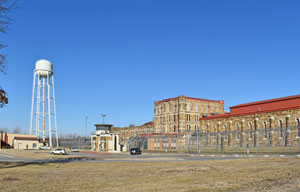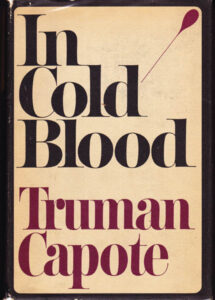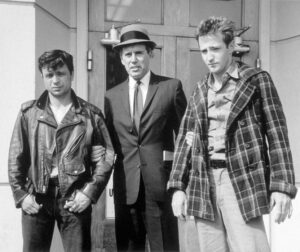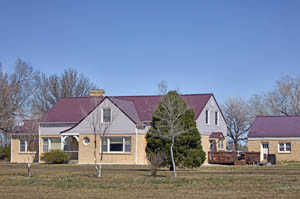In 1959, the brutal murders of four members of the Clutter family in the small farming community of Holcomb, Kansas, shocked the nation when the story hit the news. Murder of this magnitude just didn’t happen to farm families in the heartland of America.
The sordid tale began after small-time “hoods,” Richard “Dick” Hickock and Perry Smith were paroled from the Kansas State Penitentiary in Lansing, Kansas.
Richard “Dick” Eugene Hickock, age 28 at the time of the murders, was born to God-fearing parents in eastern Kansas, grew up on a farm, and dreamed of a college football scholarship. He was considered above-average intelligence and a very good athlete but was an underachieving student with a discipline problem. After the scholarship never materialized, he worked at various jobs, including as a railroad worker, auto mechanic, and ambulance driver. After two failed marriages, he was involved in a severe car accident in 1950, leaving his face permanently scarred. He then got into trouble for writing bad checks and petty theft. On March 15, 1958, he was sentenced to five years in the State Penitentiary at Lansing, Kansas, for the burglary of a home in Johnson County, Kansas. Hickock’s prison record was clean, and it was dutifully noted that he was “not dangerous.”
Perry Edward Smith was 31 years old when he murdered the Clutter family. He was born to a Native American mother and a Caucasian father who sought fame on the rodeo circuit. Both parents were alcoholics, and Smith and his siblings were frequent victims of physical violence and mental abuse. In 1948, Perry left the transient family and joined the army, serving in the Korean War. He was honorably discharged in 1952. That year, he was charged with reckless driving and resisting arrest. Shortly afterward, he was involved in a motorcycle accident that hospitalized him for six months. During that time, he underwent surgery to repair his broken legs, which left him disfigured and in chronic pain. In July 1955, he was arrested for burglary in Phillips County, Kansas, but escaped. Later that year, he was cited for vagrancy in Worcester, Massachusetts, where he was freed on a $10 bond and again vanished. In 1956, he was identified as an escapee and was sentenced on March 13, 1956, to five to ten years in the State Penitentiary at Lansing for his previous burglary and “jailbreak.”
While incarcerated, Hickok and Smith shared a cell in Lansing for two weeks.
After Smith’s parole on July 6, 1959, with supervision conditions that he was not to enter the State of Kansas while on parole or face violation, he dutifully left Kansas and drifted throughout the country performing odd jobs and living in rooming houses.
Dick Hickock finished his tenure at Lansing with a new cellmate, Floyd Wells. Wells, like Hickock, was a thief, serving three to five years for breaking into an electrical appliance store and stealing lawnmowers. During that time, Wells discussed his former employment as a farmhand working for Herbert W. Clutter, who owned the River Valley Farm in Holcomb, Kansas. He described a safe in a home office used by Clutter that contained large amounts of cash with which he paid employees and other expenses. In response, Hickok says to Wells, “As soon as I get out on parole, I’m going to find me some transportation, get ahold of Smith, and go to the Clutters’ and see if there’s still $10,000 in their damned safe.” He then relentlessly questions Wells, wanting to know the children’s ages and the house’s layout. He tells Wells that he will kill the family, leaving no witnesses.
Dick Hickock was paroled on August 13, 1959, and lived with his parents while looking for a job, which he landed at Bob Sands’ Garage in Olathe, Kansas working as an auto mechanic. He then began writing to Perry Smith several times before reaching him at a post office box in Idaho. Hickok explains his plan to make big money, describing a scenario he said was a “cinch.” Despite his parole conditions, Perry Smith agrees to meet Dick and boards a bus for Olathe.
On November 14, 1959, Dick and Perry left Olathe in a borrowed 1949 Chevy, taking a circuitous route to Holcomb. Four hundred miles and several hours later, they entered Garden City, stopping for gas at the Phillips 66. A short ride later, they arrive in view of the Clutter home near midnight and follow a dirt road to the Clutter home. When a light flashes in a nearby home, Dick Hickok momentarily reconsidered and turned the car around. Perry Smith responded, “Maybe you think I ain’t got the guts to do it alone. But by God, I’ll show you who’s got guts!”. Continuing, the two criminals parked at a side entrance and entered through an unlocked door while the family slept.
Herb Clutter, 48 years old, was one of the most respected men in Finney County, Kansas. He was a college graduate, successful wheat farmer, and community leader who could always be counted on to lend a hand. He employed as many as 18 farmhands, who admired and respected him for his fair treatment and good wages. His wife Bonnie, 45, at one time Herb’s energetic and supportive partner, was now given to prolonged periods of clinical depression and rarely left the confines of their spacious home. However, her struggles did not stop her from doting on her two children, who remained at home — Nancy, 16, and a son, Kenyon, 15, who were high school students. Two older daughters, Eveanna and Beverly, had married and moved away, starting their own families. The Clutters were decent, hard-working people who regularly attended the First Methodist Church in neighboring Garden City.
As the criminal pair entered the Clutter home, Hickock carried a knife and Smith a shotgun. Guided only by a flashlight, they searched for the safe in the quiet house. However, the search of a small paneled office yielded nothing.
As they continued through the house, they were less than careful about the noise they might be making. Herb Clutter, asleep in his bed, was awakened by a flashlight shining in his eyes. Having traveled the length of Kansas to steal the contents of Clutter’s safe and Dick and Perry were not leaving empty-handed.
Clutter was taken by gunpoint into his office, where he repeatedly told the intruders that he had no safe and transacted all of his business by check. He offered to write them a check and give them the contents of his wallet if they would leave his family in peace. After spending two hours in the house, the family awakens. Herb Clutter and his son Kenyon were taken to the basement, separated and hog-tied. In her second-floor bedroom, Nancy Clutter was tied to her bedpost, and Mrs. Clutter was removed from her bedroom and placed in the upstairs bathroom, where she was tied. Their mouths were also taped shut.
Smith then stayed in the basement while Hickock returned upstairs to resume the search for the safe. A short time later, Hickock returned to the basement, disappointed and angry, having not found the safe.
One by one, the killing began. Perry Smith goaded Dick Hickok to use the knife on Herb Clutter, who seemed incapable of doing so. Perry then grabbed the knife from Dick and set the violence in motion while Dick did nothing to stop him. Kneeling on the floor, Perry sliced the throat of Herb Clutter and challenged Dick to “finish him off,” but he was unable or unwilling. Perry then shot Clutter at close range as Dick trained the flashlight on him. Moments after Herb was killed, Smith shot Kenyon to death. The ex-convicts then headed upstairs, entering Nancy’s room, and she was shot to death. Lastly, Bonnie Clutter was killed by a gunshot wound to the side of the head.
The spent shotgun shells were retrieved by the killers before Hickock and Smith fled the crime scene, taking with them a Zenith portable radio, a pair of binoculars belonging to Herb Clutter, and less than $50 in cash.
When officers arrived, Herb Clutter, 48, lay sprawled on a mattress in the basement, stabbed, his throat slashed, and a shotgun charge fired to his head. He wore pajamas. His hands were bound, and his mouth was taped shut. On a couch in an adjoining room was 15-year-old Kenyon Neal Clutter, bound, gagged, and shot in the head. In separate upstairs bedrooms were the bodies of Mrs. Bonnie Mae Clutter, 45, and Nancy Mae Clutter, 16. Mrs. Clutter was bound and gagged; Nancy was only bound. Each had been shot in the head.
Garden City Police Department Chief Mitchell Geisler was among the first officers to arrive at the horrific scene. Accompanying him was Assistant Chief Ritch Rohleder. Rohleder was an expert photographer and used his skills to photograph the crime scene. Although the technology wasn’t nearly to the level it is today, it was through Rohleder’s photographs that the discovery of a bloody footprint remained from Smith. A photograph was also taken of a tire track left in haste by the murders.
Approximately 1,000 mourners attended the Clutter family funeral, packing the First Methodist Church in Garden City, Kansas. Most of that crowd was also present at the burial at Valley View Cemetery on the north edge of Garden City.
Alvin Dewey of the Kansas Bureau of Investigations (KBI) led the investigation with help from four other KBI investigators working under him. He also solicited the support of other governmental agencies to develop evidence and leads.
During the time Hickock and Smith spent canvassing the country, Dewey and the KBI could piece together evidence corroborated by a fellow prisoner, Floyd Wells, who had ratted out the murderers for ransom money being offered at the time. Floyd Wells later killed himself in a prison break in Mississippi.
Immediately following the murders, Hickock and Smith fled to Kansas City, where Hickock wrote a series of hot checks. After overstaying their welcome, they decided to flee to Mexico, where they lived for a short period. There, they pawned the binoculars and eventually hitchhiked their way through California en route to Omaha, Nebraska. After a short stay in Omaha, they went to Iowa, where they stole a car and returned to the Kansas City area. From Kansas City, they eventually traveled to Florida and Nevada.
Hickock and Smith were captured in Las Vegas, Nevada, on December 30, six weeks after the murders. They were still driving a stolen car they had acquired in Iowa. They also had in their possession the boot that made the bloody print. Once word got out that they had been captured, Alvin Dewey and three other KBI investigators flew to Nevada to solicit a confession from the two men.
After being extradited to Kansas, the prisoners were retained at the old-fashioned but fail-safe Finney County jail in Garden City; they were kept separated by wings. Each cell contained a cot, a toilet, a shower stall, a chair, and a table on which they could eat their meals. Smith kept a diary in a loose-leaf notebook, which included doodles and caricatures. Hickock occupied his time by reading. While Smith had little company, as his family seemed to have disowned him, Hickock’s family visited him often.
Their trial was held at the Finney County Courthouse in Garden City. Public turnout was significant, but with a capacity of 160 people in the third-floor courtroom, the benches filled fast, and many people were turned away. Up front were the press members, including a young novelist and reporter named Truman Capote, who was on assignment from The New Yorker newspaper.
Clutter’s daughters, Beverly and Eveanna, did not attend any sessions, as the event was too brutal. However, Herbert’s brother, Arthur Clutter, was there and told reporters, “The way I feel I could tear them apart.”
Over the next three days, witnesses were called for the prosecution. These included those who had discovered the bodies, the sheriff, county coroner, police investigators, FBI agents, KBI agents, forensic experts, and Floyd Wells, Hickock’s former cellmate. Though the defense tried hard to discredit some of the evidence, they had little to work with.
On March 29, 1960, after deliberating for a mere 40 minutes, a jury of all men returned a verdict of guilty of four counts of first-degree murder, and they were sentenced to death. The pair were then sent to the Kansas State Penitentiary in Lansing, Kansas (northwest of Kansas City). For the next five years, they lived on death row.
On April 14, 1965, they were hanged at the Kansas State Penitentiary. Hickock was executed first and was pronounced dead at 12:41 a.m.; Smith followed shortly afterward and was pronounced dead at 1:19 a.m.
Smith’s last words were, “I think it is a hell of a thing that a life has to be taken in this manner. I say this especially because there’s a great deal I could have offered society. I certainly think capital punishment is legally and morally wrong. Any apology for what I have done would be meaningless at this time. I don’t have any animosities toward anyone involved in this matter. I think that is all.”
Hickock’s last words were: “No, I guess I don’t.” However, he then motioned for KBI Agent Roy Church, who played a significant role in the arrest of the two men, to come to him and said, “You’re sending me to a better place than this.” He then shook hands and said, “Goodbye.”
They were both buried in Mt. Muncie cemetery in Lansing, Kansas.
Before the killers were captured, author Truman Capote learned of the Clutter family murders and decided to travel to Kansas and write about the crime. He was accompanied by his childhood friend and fellow author, Harper Lee. Together, they interviewed residents and investigators assigned to the case and took thousands of pages of notes. Capote ultimately spent six years working on his book. When finally published in 1966, In Cold Blood was an instant success. Today, it is the second-best-selling true crime book in publishing history, behind Vincent Bugliosi’s 1974 book Helter Skelter, about the Charles Manson murders.
The best-selling book spawned several filmed versions of the story, including a theatrical feature film in 1967 and a two-part television miniseries in 1996.
©Kathy Alexander/Legends of Kansas, September 2023.
Also See:
Sources:


